MGT737 Advanced Applied Management: Automation Impact on Warehouses
VerifiedAdded on 2023/06/08
|30
|6931
|126
Report
AI Summary
This research proposal investigates the impact of automation on warehouses in New Zealand, focusing on employment, risks, and the benefits of human labor compared to robotics. It aims to understand the interaction between robotics and human labor, identifying the advantages of human labor and the risks associated with automation. The methodology includes both primary research, using questionnaires and surveys with logistics companies, and secondary research, reviewing articles, journals, and books. Ethical considerations such as anonymity, confidentiality, and informed consent are addressed. The proposal also outlines a research budget, time constraints, and potential limitations, providing a comprehensive plan for exploring the future of automation in the logistics and supply chain industry in New Zealand.

Running head: ADVANCED APPLIED MANAGEMENT
ADVANCED APPLIED MANAGEMENT
Name of the Student
Name of the university
Author Note
ADVANCED APPLIED MANAGEMENT
Name of the Student
Name of the university
Author Note
Paraphrase This Document
Need a fresh take? Get an instant paraphrase of this document with our AI Paraphraser
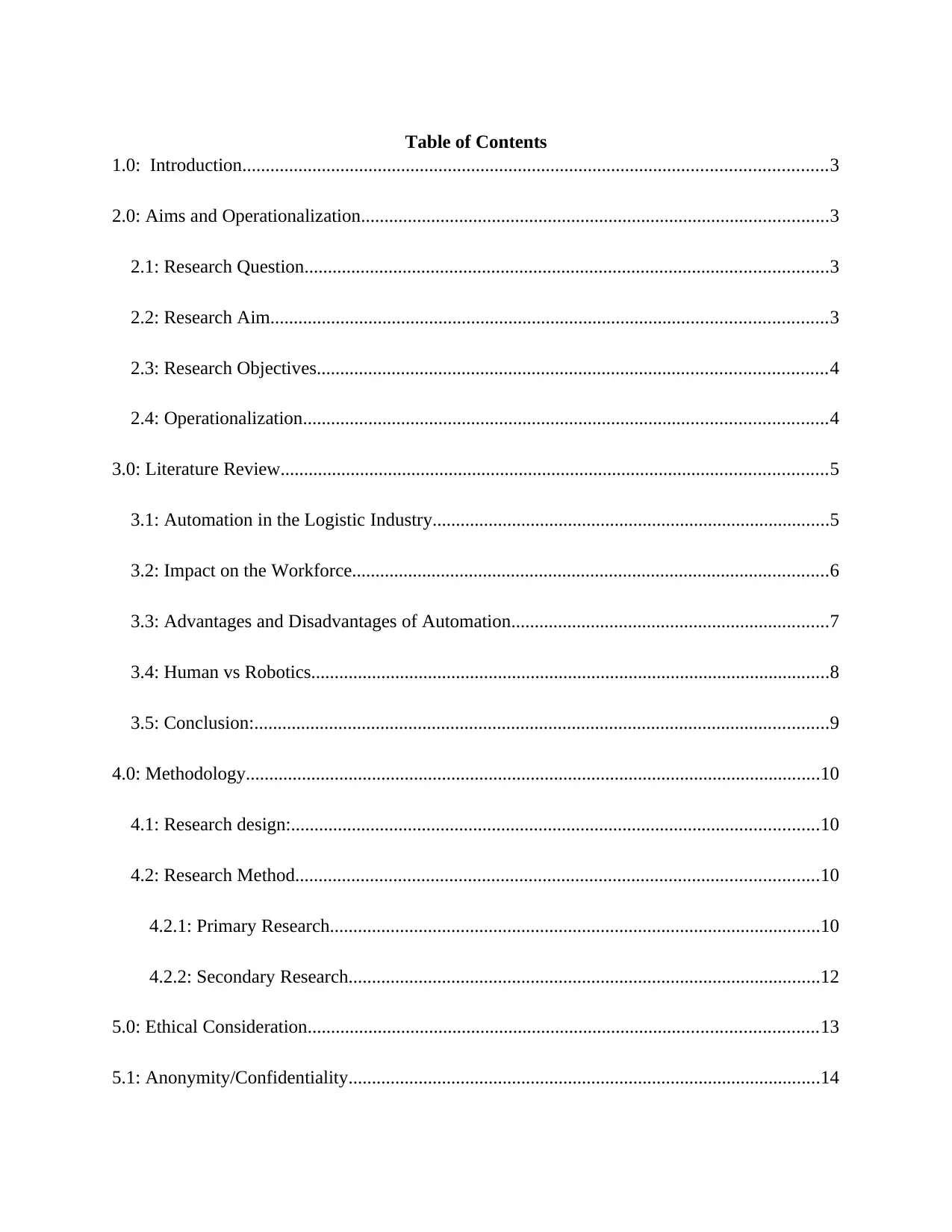
Table of Contents
1.0: Introduction.............................................................................................................................3
2.0: Aims and Operationalization....................................................................................................3
2.1: Research Question................................................................................................................3
2.2: Research Aim.......................................................................................................................3
2.3: Research Objectives.............................................................................................................4
2.4: Operationalization................................................................................................................4
3.0: Literature Review.....................................................................................................................5
3.1: Automation in the Logistic Industry.....................................................................................5
3.2: Impact on the Workforce......................................................................................................6
3.3: Advantages and Disadvantages of Automation....................................................................7
3.4: Human vs Robotics...............................................................................................................8
3.5: Conclusion:...........................................................................................................................9
4.0: Methodology...........................................................................................................................10
4.1: Research design:.................................................................................................................10
4.2: Research Method................................................................................................................10
4.2.1: Primary Research.........................................................................................................10
4.2.2: Secondary Research.....................................................................................................12
5.0: Ethical Consideration.............................................................................................................13
5.1: Anonymity/Confidentiality.....................................................................................................14
1.0: Introduction.............................................................................................................................3
2.0: Aims and Operationalization....................................................................................................3
2.1: Research Question................................................................................................................3
2.2: Research Aim.......................................................................................................................3
2.3: Research Objectives.............................................................................................................4
2.4: Operationalization................................................................................................................4
3.0: Literature Review.....................................................................................................................5
3.1: Automation in the Logistic Industry.....................................................................................5
3.2: Impact on the Workforce......................................................................................................6
3.3: Advantages and Disadvantages of Automation....................................................................7
3.4: Human vs Robotics...............................................................................................................8
3.5: Conclusion:...........................................................................................................................9
4.0: Methodology...........................................................................................................................10
4.1: Research design:.................................................................................................................10
4.2: Research Method................................................................................................................10
4.2.1: Primary Research.........................................................................................................10
4.2.2: Secondary Research.....................................................................................................12
5.0: Ethical Consideration.............................................................................................................13
5.1: Anonymity/Confidentiality.....................................................................................................14

5.2: Vulnerable Participants.......................................................................................................14
5.3: Potential Bias......................................................................................................................14
5.4: Harm to participants...........................................................................................................15
5.5: Invasion of Privacy:............................................................................................................15
5.6: Deception:...........................................................................................................................15
5.7: Contact methods of research Participants...........................................................................15
5.9: Informed Consent...............................................................................................................16
5.10: REA Supplied...................................................................................................................17
5.11: limitations.........................................................................................................................17
6.0: Research and Management Budget.......................................................................................17
6.1: Monetary.............................................................................................................................17
6.2: Time:...................................................................................................................................18
6.3: Fantasy Table of Contents..................................................................................................22
6.4: EMPHASIS CHANGE.......................................................................................................23
7.0: Bibliography:..........................................................................................................................23
5.3: Potential Bias......................................................................................................................14
5.4: Harm to participants...........................................................................................................15
5.5: Invasion of Privacy:............................................................................................................15
5.6: Deception:...........................................................................................................................15
5.7: Contact methods of research Participants...........................................................................15
5.9: Informed Consent...............................................................................................................16
5.10: REA Supplied...................................................................................................................17
5.11: limitations.........................................................................................................................17
6.0: Research and Management Budget.......................................................................................17
6.1: Monetary.............................................................................................................................17
6.2: Time:...................................................................................................................................18
6.3: Fantasy Table of Contents..................................................................................................22
6.4: EMPHASIS CHANGE.......................................................................................................23
7.0: Bibliography:..........................................................................................................................23
⊘ This is a preview!⊘
Do you want full access?
Subscribe today to unlock all pages.

Trusted by 1+ million students worldwide
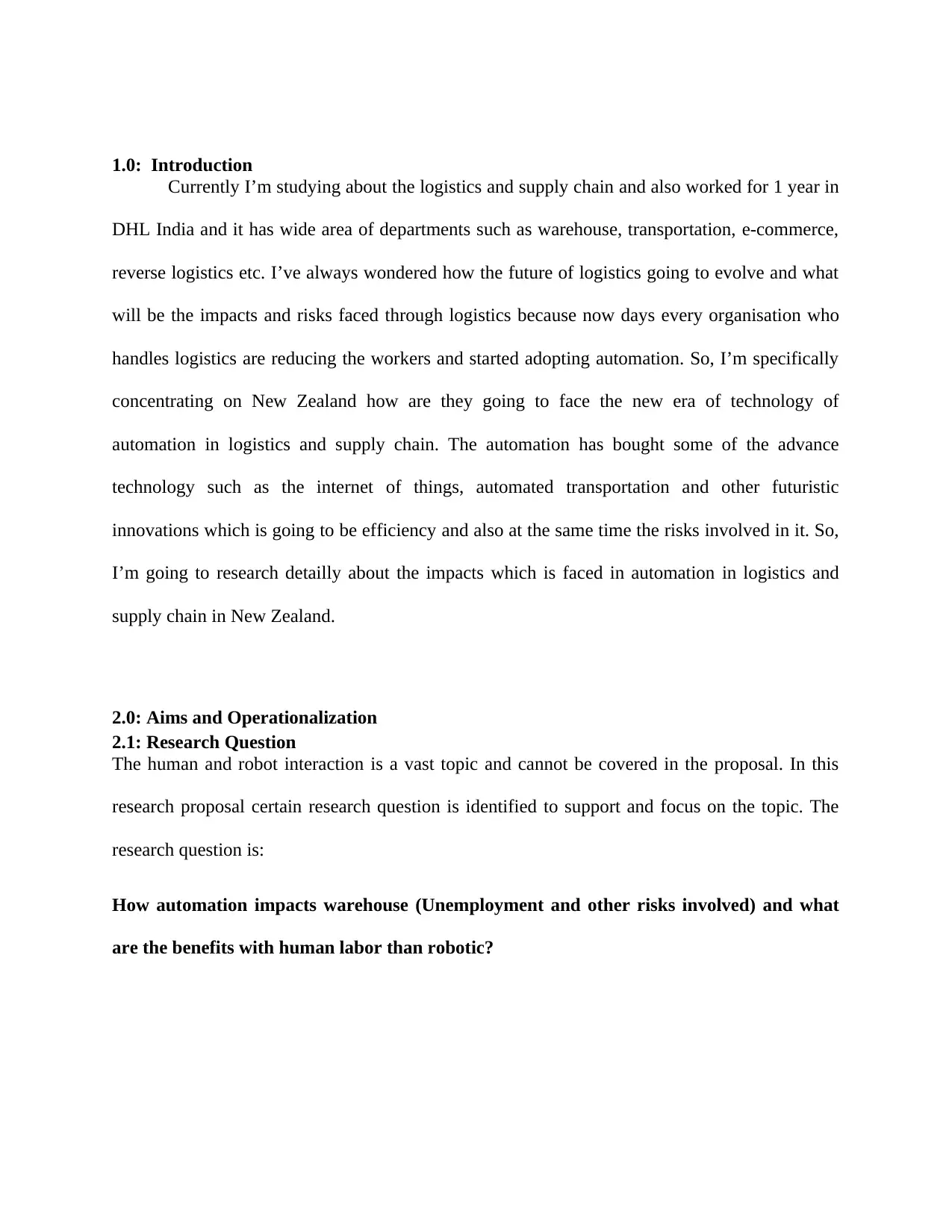
1.0: Introduction
Currently I’m studying about the logistics and supply chain and also worked for 1 year in
DHL India and it has wide area of departments such as warehouse, transportation, e-commerce,
reverse logistics etc. I’ve always wondered how the future of logistics going to evolve and what
will be the impacts and risks faced through logistics because now days every organisation who
handles logistics are reducing the workers and started adopting automation. So, I’m specifically
concentrating on New Zealand how are they going to face the new era of technology of
automation in logistics and supply chain. The automation has bought some of the advance
technology such as the internet of things, automated transportation and other futuristic
innovations which is going to be efficiency and also at the same time the risks involved in it. So,
I’m going to research detailly about the impacts which is faced in automation in logistics and
supply chain in New Zealand.
2.0: Aims and Operationalization
2.1: Research Question
The human and robot interaction is a vast topic and cannot be covered in the proposal. In this
research proposal certain research question is identified to support and focus on the topic. The
research question is:
How automation impacts warehouse (Unemployment and other risks involved) and what
are the benefits with human labor than robotic?
Currently I’m studying about the logistics and supply chain and also worked for 1 year in
DHL India and it has wide area of departments such as warehouse, transportation, e-commerce,
reverse logistics etc. I’ve always wondered how the future of logistics going to evolve and what
will be the impacts and risks faced through logistics because now days every organisation who
handles logistics are reducing the workers and started adopting automation. So, I’m specifically
concentrating on New Zealand how are they going to face the new era of technology of
automation in logistics and supply chain. The automation has bought some of the advance
technology such as the internet of things, automated transportation and other futuristic
innovations which is going to be efficiency and also at the same time the risks involved in it. So,
I’m going to research detailly about the impacts which is faced in automation in logistics and
supply chain in New Zealand.
2.0: Aims and Operationalization
2.1: Research Question
The human and robot interaction is a vast topic and cannot be covered in the proposal. In this
research proposal certain research question is identified to support and focus on the topic. The
research question is:
How automation impacts warehouse (Unemployment and other risks involved) and what
are the benefits with human labor than robotic?
Paraphrase This Document
Need a fresh take? Get an instant paraphrase of this document with our AI Paraphraser
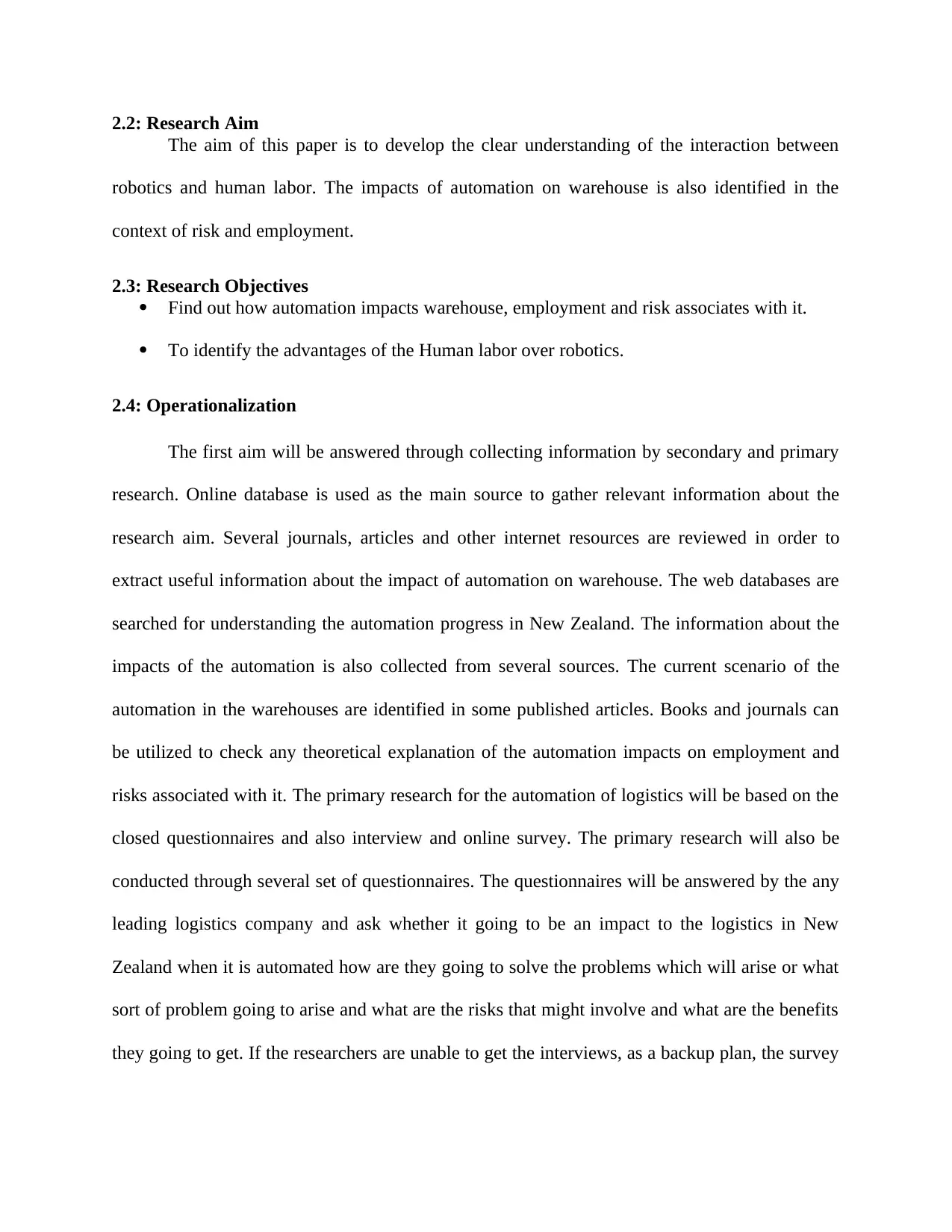
2.2: Research Aim
The aim of this paper is to develop the clear understanding of the interaction between
robotics and human labor. The impacts of automation on warehouse is also identified in the
context of risk and employment.
2.3: Research Objectives
Find out how automation impacts warehouse, employment and risk associates with it.
To identify the advantages of the Human labor over robotics.
2.4: Operationalization
The first aim will be answered through collecting information by secondary and primary
research. Online database is used as the main source to gather relevant information about the
research aim. Several journals, articles and other internet resources are reviewed in order to
extract useful information about the impact of automation on warehouse. The web databases are
searched for understanding the automation progress in New Zealand. The information about the
impacts of the automation is also collected from several sources. The current scenario of the
automation in the warehouses are identified in some published articles. Books and journals can
be utilized to check any theoretical explanation of the automation impacts on employment and
risks associated with it. The primary research for the automation of logistics will be based on the
closed questionnaires and also interview and online survey. The primary research will also be
conducted through several set of questionnaires. The questionnaires will be answered by the any
leading logistics company and ask whether it going to be an impact to the logistics in New
Zealand when it is automated how are they going to solve the problems which will arise or what
sort of problem going to arise and what are the risks that might involve and what are the benefits
they going to get. If the researchers are unable to get the interviews, as a backup plan, the survey
The aim of this paper is to develop the clear understanding of the interaction between
robotics and human labor. The impacts of automation on warehouse is also identified in the
context of risk and employment.
2.3: Research Objectives
Find out how automation impacts warehouse, employment and risk associates with it.
To identify the advantages of the Human labor over robotics.
2.4: Operationalization
The first aim will be answered through collecting information by secondary and primary
research. Online database is used as the main source to gather relevant information about the
research aim. Several journals, articles and other internet resources are reviewed in order to
extract useful information about the impact of automation on warehouse. The web databases are
searched for understanding the automation progress in New Zealand. The information about the
impacts of the automation is also collected from several sources. The current scenario of the
automation in the warehouses are identified in some published articles. Books and journals can
be utilized to check any theoretical explanation of the automation impacts on employment and
risks associated with it. The primary research for the automation of logistics will be based on the
closed questionnaires and also interview and online survey. The primary research will also be
conducted through several set of questionnaires. The questionnaires will be answered by the any
leading logistics company and ask whether it going to be an impact to the logistics in New
Zealand when it is automated how are they going to solve the problems which will arise or what
sort of problem going to arise and what are the risks that might involve and what are the benefits
they going to get. If the researchers are unable to get the interviews, as a backup plan, the survey
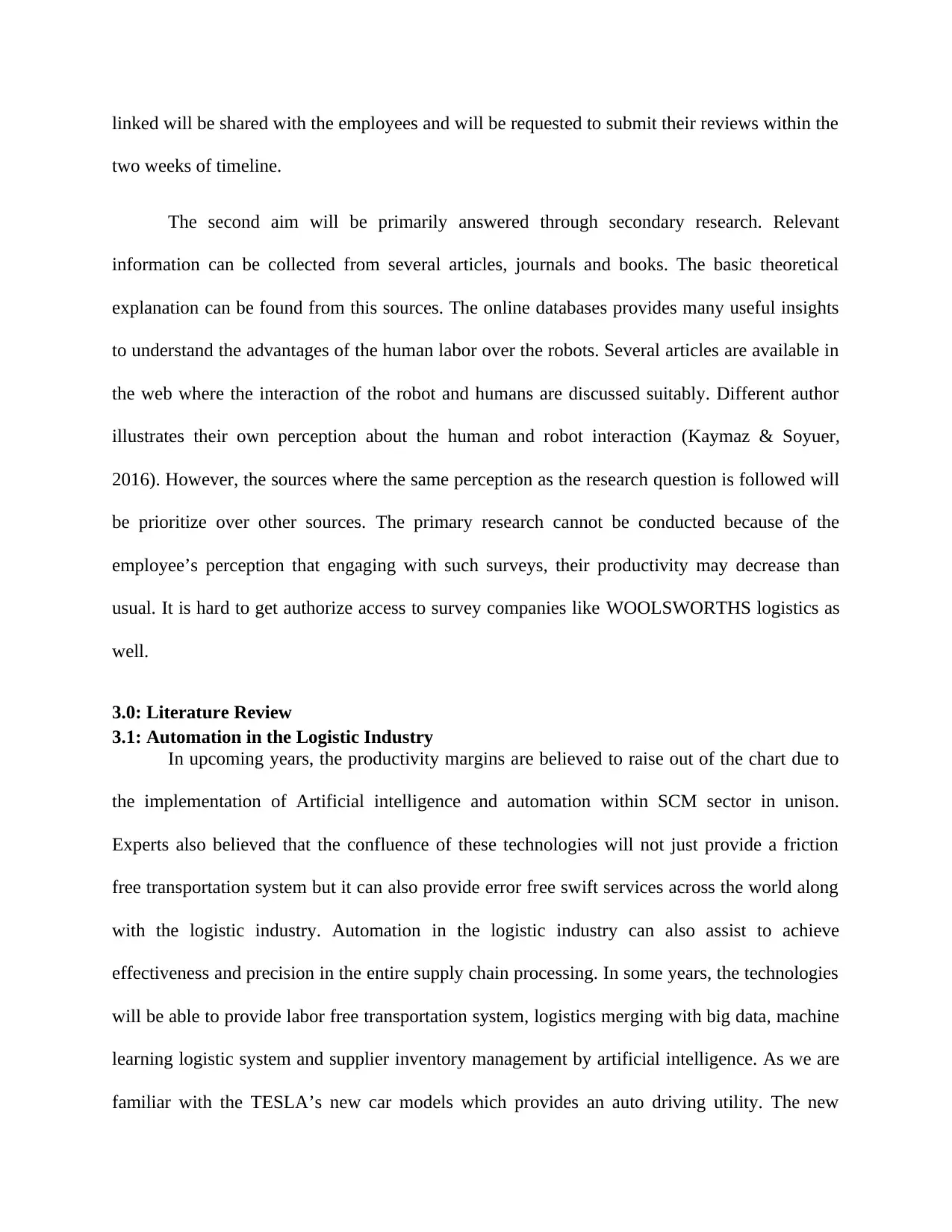
linked will be shared with the employees and will be requested to submit their reviews within the
two weeks of timeline.
The second aim will be primarily answered through secondary research. Relevant
information can be collected from several articles, journals and books. The basic theoretical
explanation can be found from this sources. The online databases provides many useful insights
to understand the advantages of the human labor over the robots. Several articles are available in
the web where the interaction of the robot and humans are discussed suitably. Different author
illustrates their own perception about the human and robot interaction (Kaymaz & Soyuer,
2016). However, the sources where the same perception as the research question is followed will
be prioritize over other sources. The primary research cannot be conducted because of the
employee’s perception that engaging with such surveys, their productivity may decrease than
usual. It is hard to get authorize access to survey companies like WOOLSWORTHS logistics as
well.
3.0: Literature Review
3.1: Automation in the Logistic Industry
In upcoming years, the productivity margins are believed to raise out of the chart due to
the implementation of Artificial intelligence and automation within SCM sector in unison.
Experts also believed that the confluence of these technologies will not just provide a friction
free transportation system but it can also provide error free swift services across the world along
with the logistic industry. Automation in the logistic industry can also assist to achieve
effectiveness and precision in the entire supply chain processing. In some years, the technologies
will be able to provide labor free transportation system, logistics merging with big data, machine
learning logistic system and supplier inventory management by artificial intelligence. As we are
familiar with the TESLA’s new car models which provides an auto driving utility. The new
two weeks of timeline.
The second aim will be primarily answered through secondary research. Relevant
information can be collected from several articles, journals and books. The basic theoretical
explanation can be found from this sources. The online databases provides many useful insights
to understand the advantages of the human labor over the robots. Several articles are available in
the web where the interaction of the robot and humans are discussed suitably. Different author
illustrates their own perception about the human and robot interaction (Kaymaz & Soyuer,
2016). However, the sources where the same perception as the research question is followed will
be prioritize over other sources. The primary research cannot be conducted because of the
employee’s perception that engaging with such surveys, their productivity may decrease than
usual. It is hard to get authorize access to survey companies like WOOLSWORTHS logistics as
well.
3.0: Literature Review
3.1: Automation in the Logistic Industry
In upcoming years, the productivity margins are believed to raise out of the chart due to
the implementation of Artificial intelligence and automation within SCM sector in unison.
Experts also believed that the confluence of these technologies will not just provide a friction
free transportation system but it can also provide error free swift services across the world along
with the logistic industry. Automation in the logistic industry can also assist to achieve
effectiveness and precision in the entire supply chain processing. In some years, the technologies
will be able to provide labor free transportation system, logistics merging with big data, machine
learning logistic system and supplier inventory management by artificial intelligence. As we are
familiar with the TESLA’s new car models which provides an auto driving utility. The new
⊘ This is a preview!⊘
Do you want full access?
Subscribe today to unlock all pages.

Trusted by 1+ million students worldwide
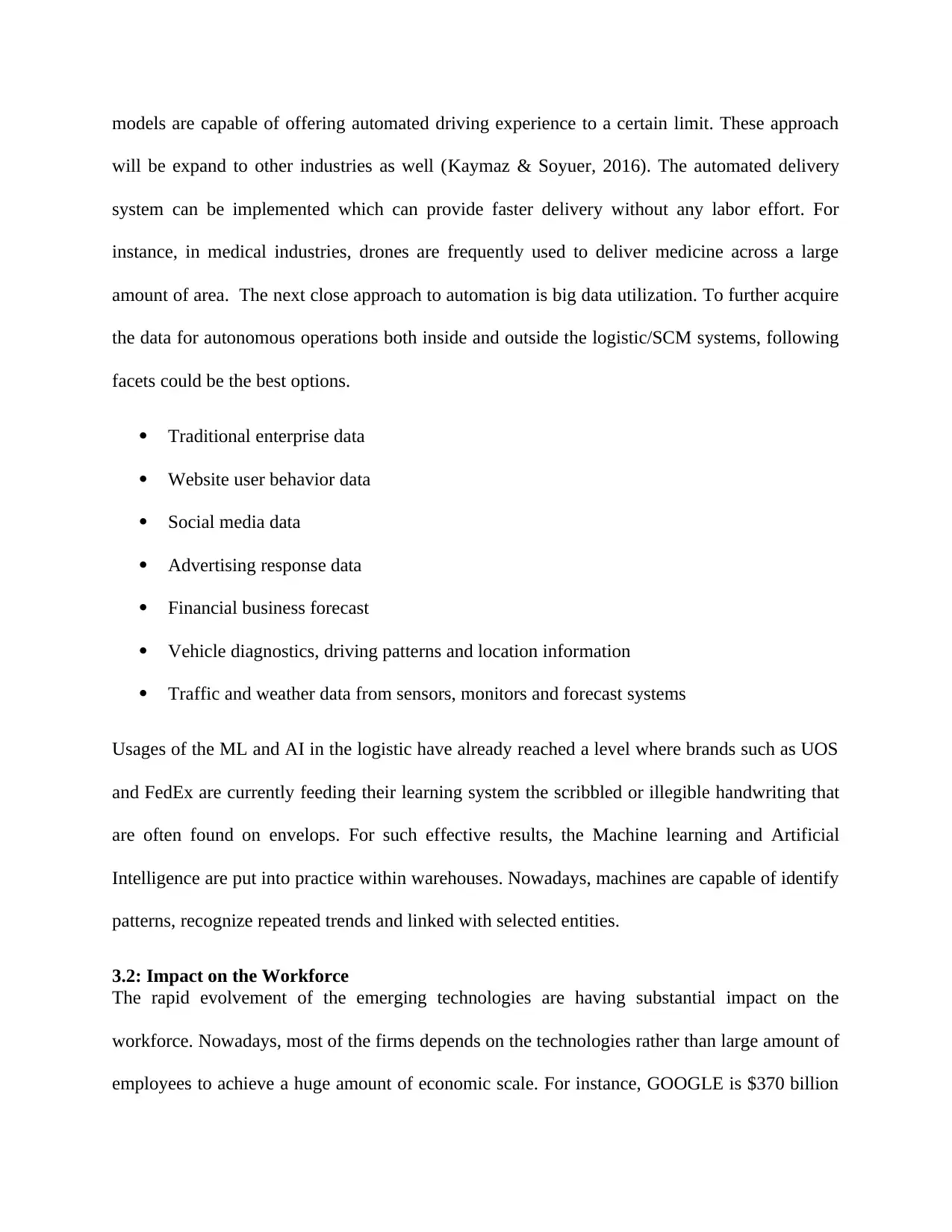
models are capable of offering automated driving experience to a certain limit. These approach
will be expand to other industries as well (Kaymaz & Soyuer, 2016). The automated delivery
system can be implemented which can provide faster delivery without any labor effort. For
instance, in medical industries, drones are frequently used to deliver medicine across a large
amount of area. The next close approach to automation is big data utilization. To further acquire
the data for autonomous operations both inside and outside the logistic/SCM systems, following
facets could be the best options.
Traditional enterprise data
Website user behavior data
Social media data
Advertising response data
Financial business forecast
Vehicle diagnostics, driving patterns and location information
Traffic and weather data from sensors, monitors and forecast systems
Usages of the ML and AI in the logistic have already reached a level where brands such as UOS
and FedEx are currently feeding their learning system the scribbled or illegible handwriting that
are often found on envelops. For such effective results, the Machine learning and Artificial
Intelligence are put into practice within warehouses. Nowadays, machines are capable of identify
patterns, recognize repeated trends and linked with selected entities.
3.2: Impact on the Workforce
The rapid evolvement of the emerging technologies are having substantial impact on the
workforce. Nowadays, most of the firms depends on the technologies rather than large amount of
employees to achieve a huge amount of economic scale. For instance, GOOGLE is $370 billion
will be expand to other industries as well (Kaymaz & Soyuer, 2016). The automated delivery
system can be implemented which can provide faster delivery without any labor effort. For
instance, in medical industries, drones are frequently used to deliver medicine across a large
amount of area. The next close approach to automation is big data utilization. To further acquire
the data for autonomous operations both inside and outside the logistic/SCM systems, following
facets could be the best options.
Traditional enterprise data
Website user behavior data
Social media data
Advertising response data
Financial business forecast
Vehicle diagnostics, driving patterns and location information
Traffic and weather data from sensors, monitors and forecast systems
Usages of the ML and AI in the logistic have already reached a level where brands such as UOS
and FedEx are currently feeding their learning system the scribbled or illegible handwriting that
are often found on envelops. For such effective results, the Machine learning and Artificial
Intelligence are put into practice within warehouses. Nowadays, machines are capable of identify
patterns, recognize repeated trends and linked with selected entities.
3.2: Impact on the Workforce
The rapid evolvement of the emerging technologies are having substantial impact on the
workforce. Nowadays, most of the firms depends on the technologies rather than large amount of
employees to achieve a huge amount of economic scale. For instance, GOOGLE is $370 billion
Paraphrase This Document
Need a fresh take? Get an instant paraphrase of this document with our AI Paraphraser
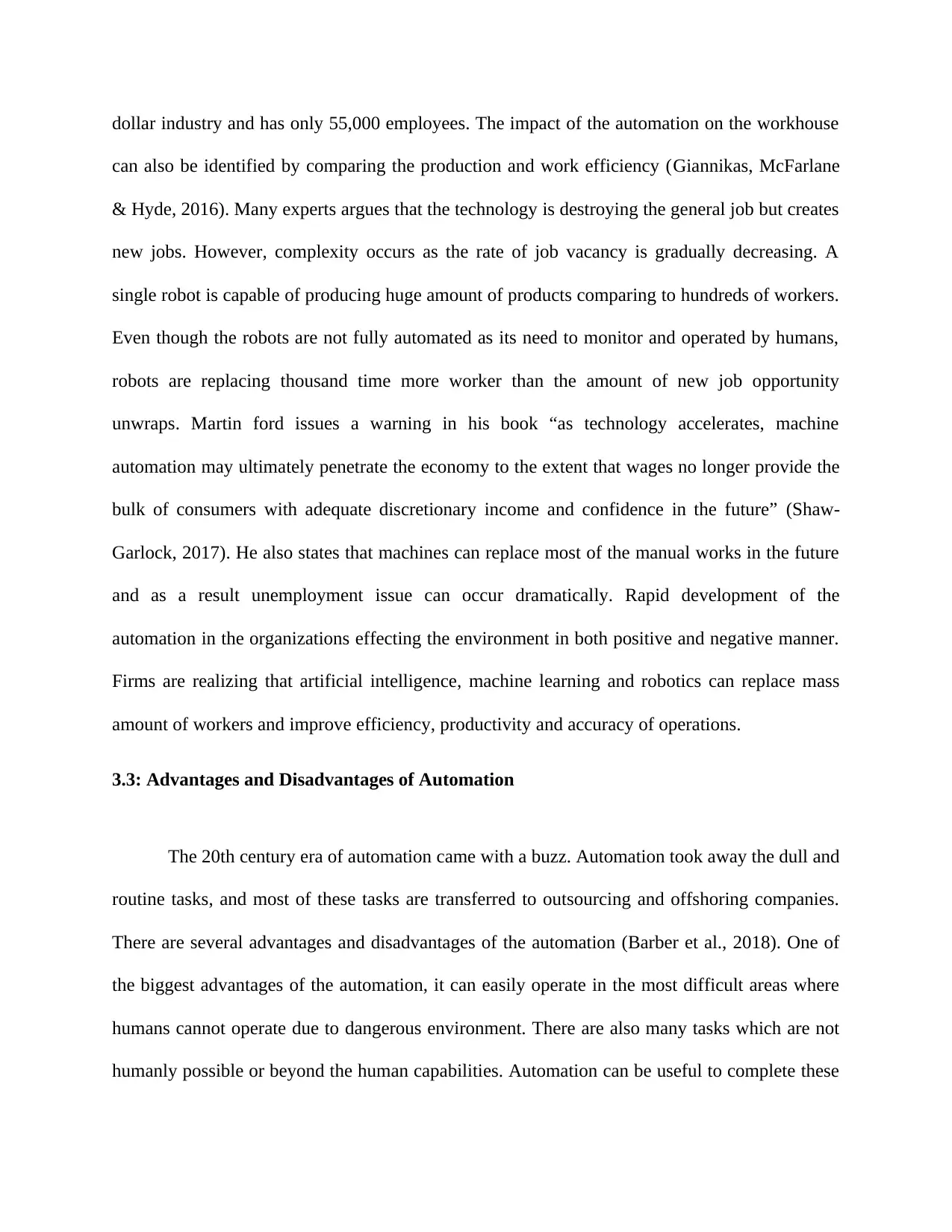
dollar industry and has only 55,000 employees. The impact of the automation on the workhouse
can also be identified by comparing the production and work efficiency (Giannikas, McFarlane
& Hyde, 2016). Many experts argues that the technology is destroying the general job but creates
new jobs. However, complexity occurs as the rate of job vacancy is gradually decreasing. A
single robot is capable of producing huge amount of products comparing to hundreds of workers.
Even though the robots are not fully automated as its need to monitor and operated by humans,
robots are replacing thousand time more worker than the amount of new job opportunity
unwraps. Martin ford issues a warning in his book “as technology accelerates, machine
automation may ultimately penetrate the economy to the extent that wages no longer provide the
bulk of consumers with adequate discretionary income and confidence in the future” (Shaw-
Garlock, 2017). He also states that machines can replace most of the manual works in the future
and as a result unemployment issue can occur dramatically. Rapid development of the
automation in the organizations effecting the environment in both positive and negative manner.
Firms are realizing that artificial intelligence, machine learning and robotics can replace mass
amount of workers and improve efficiency, productivity and accuracy of operations.
3.3: Advantages and Disadvantages of Automation
The 20th century era of automation came with a buzz. Automation took away the dull and
routine tasks, and most of these tasks are transferred to outsourcing and offshoring companies.
There are several advantages and disadvantages of the automation (Barber et al., 2018). One of
the biggest advantages of the automation, it can easily operate in the most difficult areas where
humans cannot operate due to dangerous environment. There are also many tasks which are not
humanly possible or beyond the human capabilities. Automation can be useful to complete these
can also be identified by comparing the production and work efficiency (Giannikas, McFarlane
& Hyde, 2016). Many experts argues that the technology is destroying the general job but creates
new jobs. However, complexity occurs as the rate of job vacancy is gradually decreasing. A
single robot is capable of producing huge amount of products comparing to hundreds of workers.
Even though the robots are not fully automated as its need to monitor and operated by humans,
robots are replacing thousand time more worker than the amount of new job opportunity
unwraps. Martin ford issues a warning in his book “as technology accelerates, machine
automation may ultimately penetrate the economy to the extent that wages no longer provide the
bulk of consumers with adequate discretionary income and confidence in the future” (Shaw-
Garlock, 2017). He also states that machines can replace most of the manual works in the future
and as a result unemployment issue can occur dramatically. Rapid development of the
automation in the organizations effecting the environment in both positive and negative manner.
Firms are realizing that artificial intelligence, machine learning and robotics can replace mass
amount of workers and improve efficiency, productivity and accuracy of operations.
3.3: Advantages and Disadvantages of Automation
The 20th century era of automation came with a buzz. Automation took away the dull and
routine tasks, and most of these tasks are transferred to outsourcing and offshoring companies.
There are several advantages and disadvantages of the automation (Barber et al., 2018). One of
the biggest advantages of the automation, it can easily operate in the most difficult areas where
humans cannot operate due to dangerous environment. There are also many tasks which are not
humanly possible or beyond the human capabilities. Automation can be useful to complete these
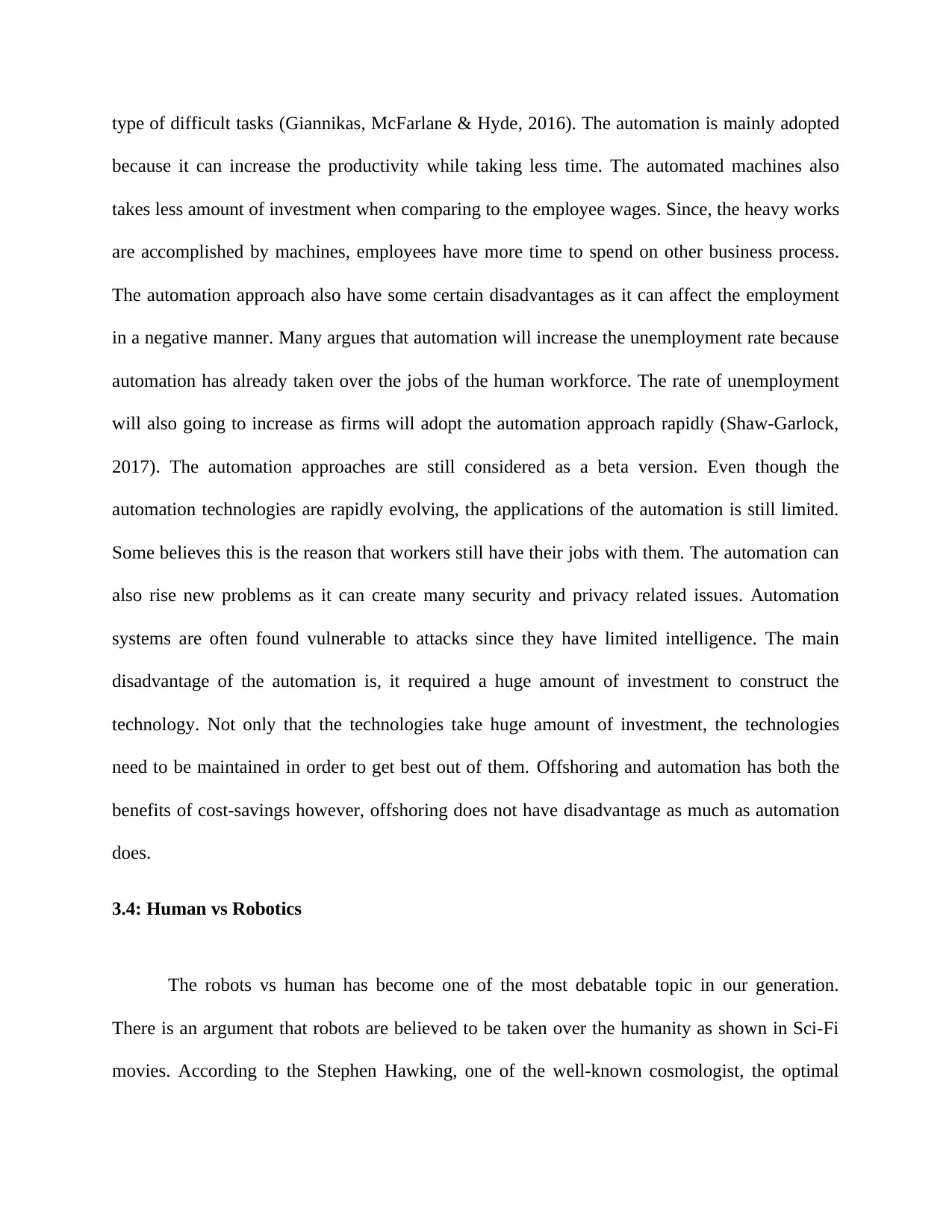
type of difficult tasks (Giannikas, McFarlane & Hyde, 2016). The automation is mainly adopted
because it can increase the productivity while taking less time. The automated machines also
takes less amount of investment when comparing to the employee wages. Since, the heavy works
are accomplished by machines, employees have more time to spend on other business process.
The automation approach also have some certain disadvantages as it can affect the employment
in a negative manner. Many argues that automation will increase the unemployment rate because
automation has already taken over the jobs of the human workforce. The rate of unemployment
will also going to increase as firms will adopt the automation approach rapidly (Shaw-Garlock,
2017). The automation approaches are still considered as a beta version. Even though the
automation technologies are rapidly evolving, the applications of the automation is still limited.
Some believes this is the reason that workers still have their jobs with them. The automation can
also rise new problems as it can create many security and privacy related issues. Automation
systems are often found vulnerable to attacks since they have limited intelligence. The main
disadvantage of the automation is, it required a huge amount of investment to construct the
technology. Not only that the technologies take huge amount of investment, the technologies
need to be maintained in order to get best out of them. Offshoring and automation has both the
benefits of cost-savings however, offshoring does not have disadvantage as much as automation
does.
3.4: Human vs Robotics
The robots vs human has become one of the most debatable topic in our generation.
There is an argument that robots are believed to be taken over the humanity as shown in Sci-Fi
movies. According to the Stephen Hawking, one of the well-known cosmologist, the optimal
because it can increase the productivity while taking less time. The automated machines also
takes less amount of investment when comparing to the employee wages. Since, the heavy works
are accomplished by machines, employees have more time to spend on other business process.
The automation approach also have some certain disadvantages as it can affect the employment
in a negative manner. Many argues that automation will increase the unemployment rate because
automation has already taken over the jobs of the human workforce. The rate of unemployment
will also going to increase as firms will adopt the automation approach rapidly (Shaw-Garlock,
2017). The automation approaches are still considered as a beta version. Even though the
automation technologies are rapidly evolving, the applications of the automation is still limited.
Some believes this is the reason that workers still have their jobs with them. The automation can
also rise new problems as it can create many security and privacy related issues. Automation
systems are often found vulnerable to attacks since they have limited intelligence. The main
disadvantage of the automation is, it required a huge amount of investment to construct the
technology. Not only that the technologies take huge amount of investment, the technologies
need to be maintained in order to get best out of them. Offshoring and automation has both the
benefits of cost-savings however, offshoring does not have disadvantage as much as automation
does.
3.4: Human vs Robotics
The robots vs human has become one of the most debatable topic in our generation.
There is an argument that robots are believed to be taken over the humanity as shown in Sci-Fi
movies. According to the Stephen Hawking, one of the well-known cosmologist, the optimal
⊘ This is a preview!⊘
Do you want full access?
Subscribe today to unlock all pages.

Trusted by 1+ million students worldwide
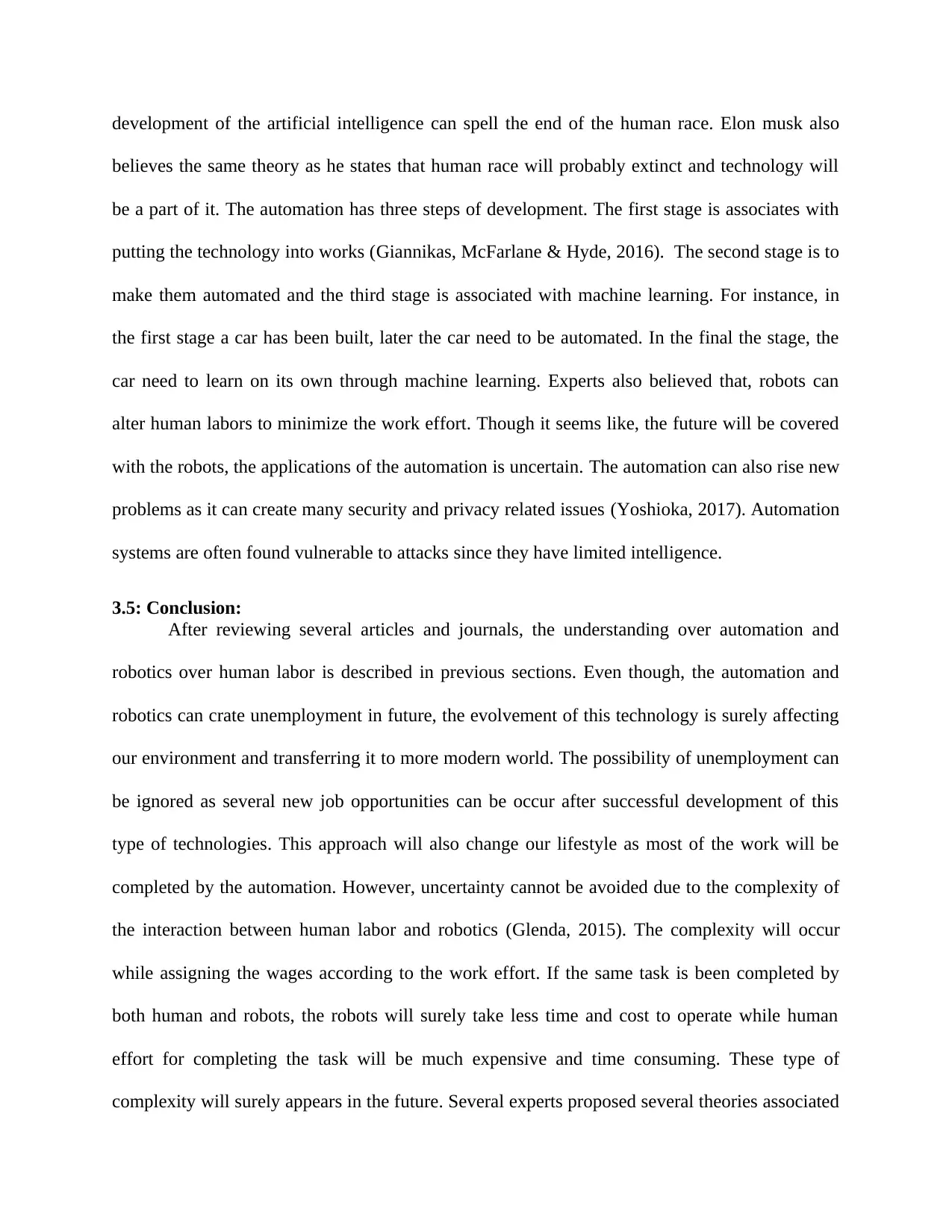
development of the artificial intelligence can spell the end of the human race. Elon musk also
believes the same theory as he states that human race will probably extinct and technology will
be a part of it. The automation has three steps of development. The first stage is associates with
putting the technology into works (Giannikas, McFarlane & Hyde, 2016). The second stage is to
make them automated and the third stage is associated with machine learning. For instance, in
the first stage a car has been built, later the car need to be automated. In the final the stage, the
car need to learn on its own through machine learning. Experts also believed that, robots can
alter human labors to minimize the work effort. Though it seems like, the future will be covered
with the robots, the applications of the automation is uncertain. The automation can also rise new
problems as it can create many security and privacy related issues (Yoshioka, 2017). Automation
systems are often found vulnerable to attacks since they have limited intelligence.
3.5: Conclusion:
After reviewing several articles and journals, the understanding over automation and
robotics over human labor is described in previous sections. Even though, the automation and
robotics can crate unemployment in future, the evolvement of this technology is surely affecting
our environment and transferring it to more modern world. The possibility of unemployment can
be ignored as several new job opportunities can be occur after successful development of this
type of technologies. This approach will also change our lifestyle as most of the work will be
completed by the automation. However, uncertainty cannot be avoided due to the complexity of
the interaction between human labor and robotics (Glenda, 2015). The complexity will occur
while assigning the wages according to the work effort. If the same task is been completed by
both human and robots, the robots will surely take less time and cost to operate while human
effort for completing the task will be much expensive and time consuming. These type of
complexity will surely appears in the future. Several experts proposed several theories associated
believes the same theory as he states that human race will probably extinct and technology will
be a part of it. The automation has three steps of development. The first stage is associates with
putting the technology into works (Giannikas, McFarlane & Hyde, 2016). The second stage is to
make them automated and the third stage is associated with machine learning. For instance, in
the first stage a car has been built, later the car need to be automated. In the final the stage, the
car need to learn on its own through machine learning. Experts also believed that, robots can
alter human labors to minimize the work effort. Though it seems like, the future will be covered
with the robots, the applications of the automation is uncertain. The automation can also rise new
problems as it can create many security and privacy related issues (Yoshioka, 2017). Automation
systems are often found vulnerable to attacks since they have limited intelligence.
3.5: Conclusion:
After reviewing several articles and journals, the understanding over automation and
robotics over human labor is described in previous sections. Even though, the automation and
robotics can crate unemployment in future, the evolvement of this technology is surely affecting
our environment and transferring it to more modern world. The possibility of unemployment can
be ignored as several new job opportunities can be occur after successful development of this
type of technologies. This approach will also change our lifestyle as most of the work will be
completed by the automation. However, uncertainty cannot be avoided due to the complexity of
the interaction between human labor and robotics (Glenda, 2015). The complexity will occur
while assigning the wages according to the work effort. If the same task is been completed by
both human and robots, the robots will surely take less time and cost to operate while human
effort for completing the task will be much expensive and time consuming. These type of
complexity will surely appears in the future. Several experts proposed several theories associated
Paraphrase This Document
Need a fresh take? Get an instant paraphrase of this document with our AI Paraphraser
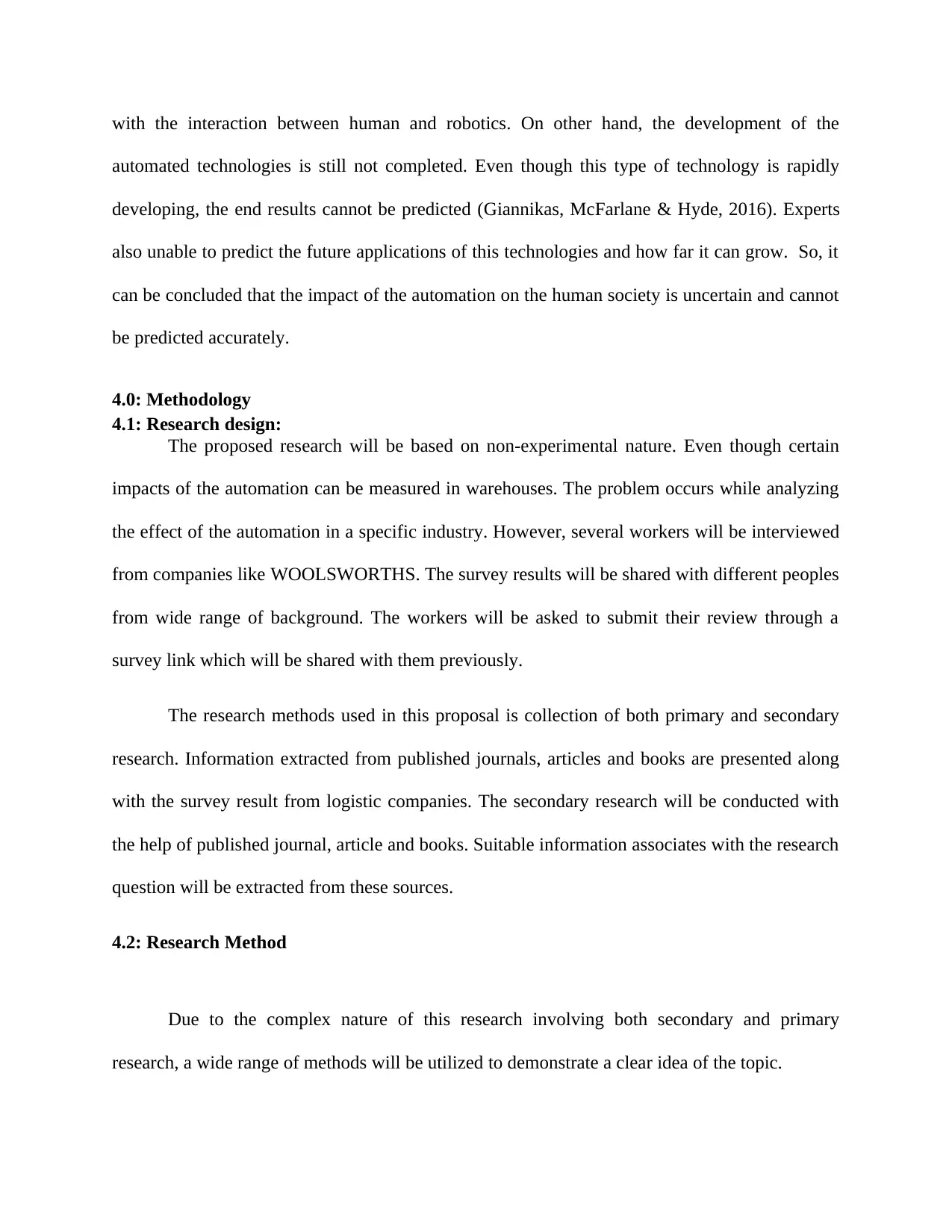
with the interaction between human and robotics. On other hand, the development of the
automated technologies is still not completed. Even though this type of technology is rapidly
developing, the end results cannot be predicted (Giannikas, McFarlane & Hyde, 2016). Experts
also unable to predict the future applications of this technologies and how far it can grow. So, it
can be concluded that the impact of the automation on the human society is uncertain and cannot
be predicted accurately.
4.0: Methodology
4.1: Research design:
The proposed research will be based on non-experimental nature. Even though certain
impacts of the automation can be measured in warehouses. The problem occurs while analyzing
the effect of the automation in a specific industry. However, several workers will be interviewed
from companies like WOOLSWORTHS. The survey results will be shared with different peoples
from wide range of background. The workers will be asked to submit their review through a
survey link which will be shared with them previously.
The research methods used in this proposal is collection of both primary and secondary
research. Information extracted from published journals, articles and books are presented along
with the survey result from logistic companies. The secondary research will be conducted with
the help of published journal, article and books. Suitable information associates with the research
question will be extracted from these sources.
4.2: Research Method
Due to the complex nature of this research involving both secondary and primary
research, a wide range of methods will be utilized to demonstrate a clear idea of the topic.
automated technologies is still not completed. Even though this type of technology is rapidly
developing, the end results cannot be predicted (Giannikas, McFarlane & Hyde, 2016). Experts
also unable to predict the future applications of this technologies and how far it can grow. So, it
can be concluded that the impact of the automation on the human society is uncertain and cannot
be predicted accurately.
4.0: Methodology
4.1: Research design:
The proposed research will be based on non-experimental nature. Even though certain
impacts of the automation can be measured in warehouses. The problem occurs while analyzing
the effect of the automation in a specific industry. However, several workers will be interviewed
from companies like WOOLSWORTHS. The survey results will be shared with different peoples
from wide range of background. The workers will be asked to submit their review through a
survey link which will be shared with them previously.
The research methods used in this proposal is collection of both primary and secondary
research. Information extracted from published journals, articles and books are presented along
with the survey result from logistic companies. The secondary research will be conducted with
the help of published journal, article and books. Suitable information associates with the research
question will be extracted from these sources.
4.2: Research Method
Due to the complex nature of this research involving both secondary and primary
research, a wide range of methods will be utilized to demonstrate a clear idea of the topic.
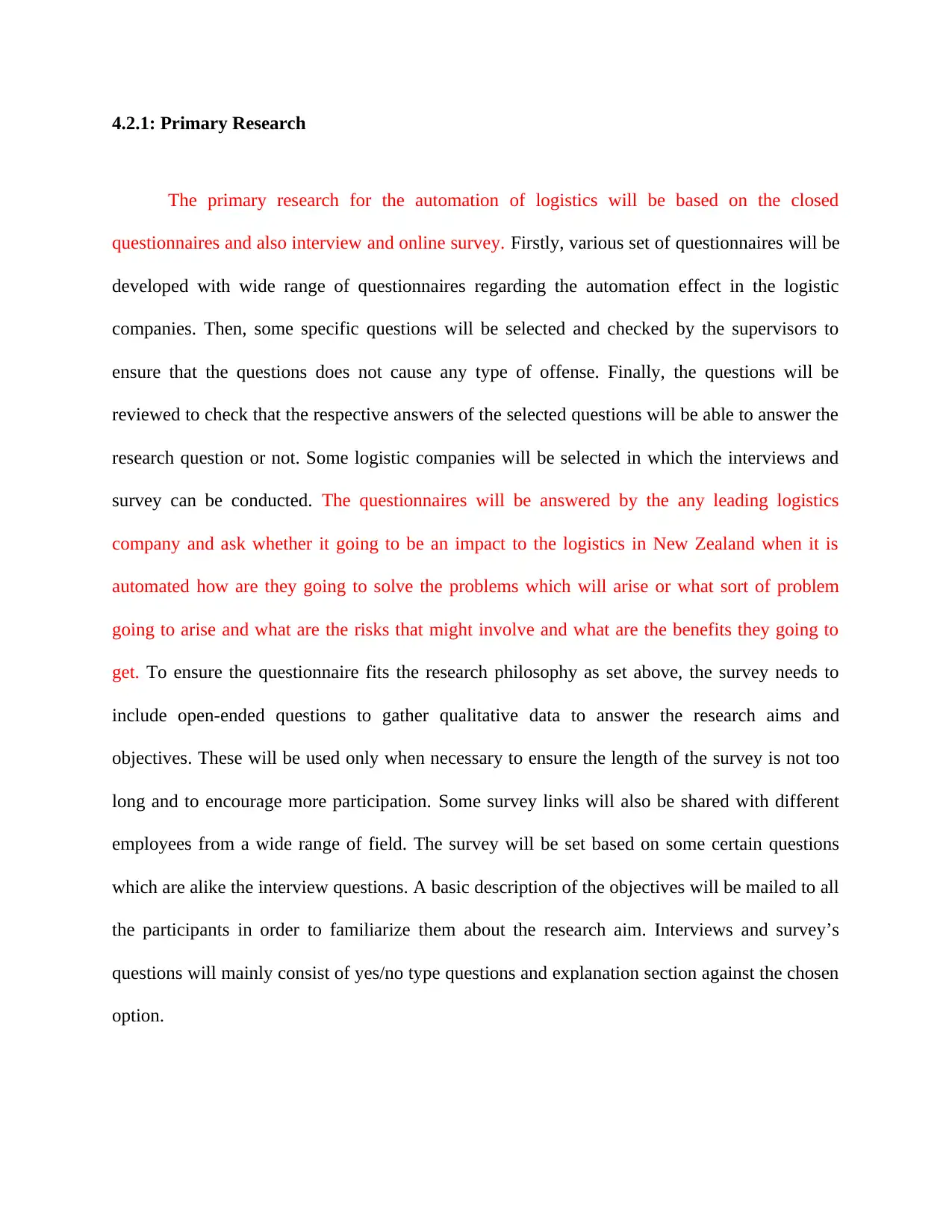
4.2.1: Primary Research
The primary research for the automation of logistics will be based on the closed
questionnaires and also interview and online survey. Firstly, various set of questionnaires will be
developed with wide range of questionnaires regarding the automation effect in the logistic
companies. Then, some specific questions will be selected and checked by the supervisors to
ensure that the questions does not cause any type of offense. Finally, the questions will be
reviewed to check that the respective answers of the selected questions will be able to answer the
research question or not. Some logistic companies will be selected in which the interviews and
survey can be conducted. The questionnaires will be answered by the any leading logistics
company and ask whether it going to be an impact to the logistics in New Zealand when it is
automated how are they going to solve the problems which will arise or what sort of problem
going to arise and what are the risks that might involve and what are the benefits they going to
get. To ensure the questionnaire fits the research philosophy as set above, the survey needs to
include open-ended questions to gather qualitative data to answer the research aims and
objectives. These will be used only when necessary to ensure the length of the survey is not too
long and to encourage more participation. Some survey links will also be shared with different
employees from a wide range of field. The survey will be set based on some certain questions
which are alike the interview questions. A basic description of the objectives will be mailed to all
the participants in order to familiarize them about the research aim. Interviews and survey’s
questions will mainly consist of yes/no type questions and explanation section against the chosen
option.
The primary research for the automation of logistics will be based on the closed
questionnaires and also interview and online survey. Firstly, various set of questionnaires will be
developed with wide range of questionnaires regarding the automation effect in the logistic
companies. Then, some specific questions will be selected and checked by the supervisors to
ensure that the questions does not cause any type of offense. Finally, the questions will be
reviewed to check that the respective answers of the selected questions will be able to answer the
research question or not. Some logistic companies will be selected in which the interviews and
survey can be conducted. The questionnaires will be answered by the any leading logistics
company and ask whether it going to be an impact to the logistics in New Zealand when it is
automated how are they going to solve the problems which will arise or what sort of problem
going to arise and what are the risks that might involve and what are the benefits they going to
get. To ensure the questionnaire fits the research philosophy as set above, the survey needs to
include open-ended questions to gather qualitative data to answer the research aims and
objectives. These will be used only when necessary to ensure the length of the survey is not too
long and to encourage more participation. Some survey links will also be shared with different
employees from a wide range of field. The survey will be set based on some certain questions
which are alike the interview questions. A basic description of the objectives will be mailed to all
the participants in order to familiarize them about the research aim. Interviews and survey’s
questions will mainly consist of yes/no type questions and explanation section against the chosen
option.
⊘ This is a preview!⊘
Do you want full access?
Subscribe today to unlock all pages.

Trusted by 1+ million students worldwide
1 out of 30
Related Documents
Your All-in-One AI-Powered Toolkit for Academic Success.
+13062052269
info@desklib.com
Available 24*7 on WhatsApp / Email
![[object Object]](/_next/static/media/star-bottom.7253800d.svg)
Unlock your academic potential
Copyright © 2020–2025 A2Z Services. All Rights Reserved. Developed and managed by ZUCOL.





